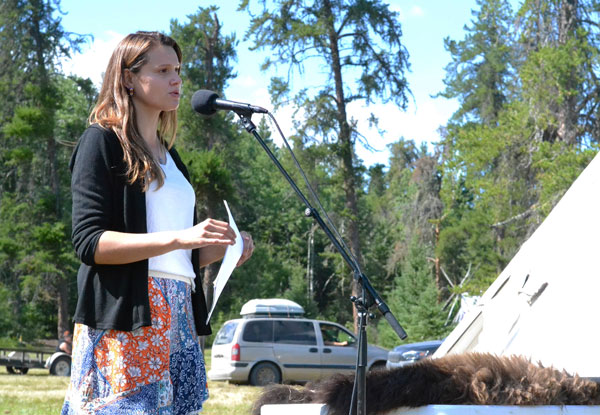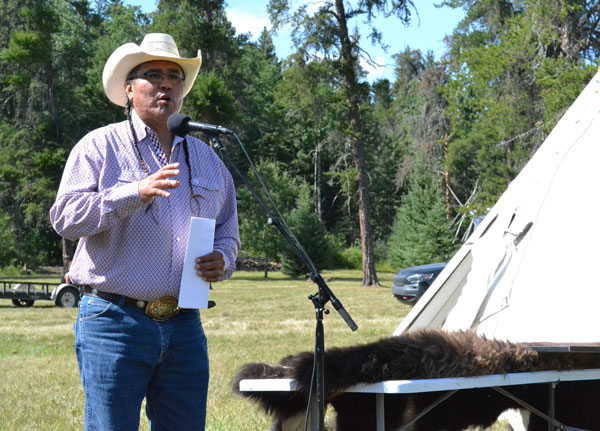
Sask. partners express need for sustainable populations at Buffalo Treaty Gathering
Speeches at the Buffalo Treaty Gathering on Tuesday were bittersweet as several spoke about the rapid decline of buffalo and the intense desire to bring them back.
The gathering took place at the Paspiwin Cultural Heritage Site in Prince Albert National Park. It consisted of a pipe ceremony, sharing of buffalo stories, traditional dancing and several speakers.
The Prince Albert Model Forest’s Sarah Schmid spoke about the history of the Buffalo Treaty in place of Educator Leroy Littlebear, who was unable to attend.
“The concept of the Buffalo Treaty actually began with a dream—a dream to bring buffalo back to the land and back into Indigenous culture; to reawaken, really, the connection with the buffalo,” she explained.

The original signing occurred in September of 2014 at the BlackFeet Nation in Montana.
Since then, nearly 20 other nations have joined.
One of them is Mistawasis First Nation, a Cree community located about an hour west of Prince Albert. Councillors Steven Johnston and William Badger spoke on the nation’s behalf.
Steven emphasized their loss of language and how they need it to understand traditional stories of the buffalo.
He said First Nations people and the buffalo have a sad similarity: “Like us as Nêhiyawak people (Cree people), we were put away also. We were put away in our communities on reservations. We weren’t allowed to move freely. We weren’t allowed to do a lot of things.”
Anthony Blair Dreaver Johnston, also a member of Mistawasis First Nation, is a longtime advocate of buffalo conservation.
“We’ve heard terms such as self-government, self-determination, sovereignty, but who are we as people?” asked Anthony. He said the land defined them, but people of the Great Plains currently have a void in their lives without the buffalo.
“We need our brother buffalo beside us, physically beside us.”
The Sturgeon River Plains Bison herd calls the northwest part of Prince Albert National Park home.
It dates back to 1969, when the Ministry of Environment released about 50 buffalo from Elk Island National Park in Alberta into the Thunder Hills area. They dispersed, some finding their way to Prince Albert National Park.
The herd’s population reached a peak of between 450 and 500 buffalo in 2006, said Parks Canada’s Joanne Watson.
Since then, the herd has been in a steady decline because of predation, disease and harvesting.
Watson said in 2008, Parks Canada estimated they lost about 60 animals to an anthrax outbreak.
She said Parks Canada and its partners have conducted several studies of the Sturgeon River Plains Bison, including behaviour and movement patterns.
When it comes to hunting, Watson explained, many were harvesting breeding females. Parks Canada worked to communicate with them to hunt the bulls instead or less buffalo in general.
She said this is all in hopes that the herd will grow to a sustainable population again.
Schmid said those who decide to join the Buffalo Treaty must attend the annual meeting to sign the original document.
This year’s meeting is being held in September at Samson Cree Nation in Alberta. Coun. Kurt Buffalo was at the gathering on Tuesday to speak about the event.
His nation signed the Buffalo Treaty in 2015.
He said a former chief always says the buffalo are like Walmart: “It’s better than Walmart. It provides everything. If Walmart had a religious section, maybe they’d catch up to our buffalo.”

“If you just look around you, we’re all children of one mother…really, that’s kind of the whole message in delivering this Buffalo Treaty. It’s about being stewards of Mother Earth,” said Buffalo.
Canadian Parks and Wilderness Society Saskatchewan Executive Director, Gord Vaadeland, also made a speech.
He pointed out that this year is the 50th anniversary of the buffalo being released that formed the Sturgeon River Plains Bison.
“I was two (years old) when that happened, and I remember it because we were there. Bison were running around, helicopters were flying under power lines to try and chase them and they were on our land,” he recalled.
“We’re taking care of them again and we’re going to get them back. You know, you hear people using this cliché ‘It’s my life’s work.’ But I’m telling you, this is my life’s work.”
The Saskatchewan Indian and Gaming Authority, the Office of the Treaty Commissioner and Saskatchewan Indigenous and Northern Relations funded the event.

